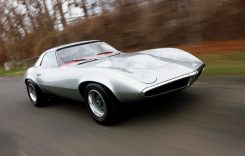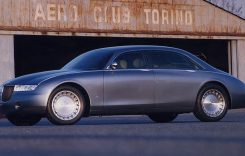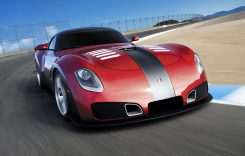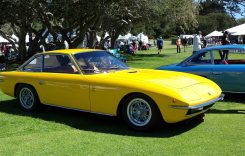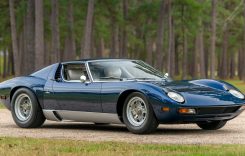Yamaha turned things around, literally, with its 2010 YZ450F and signature rear-facing engine configuration. Ever since, it’s been a waiting game for the 250 MX sibling to follow suit. Now for the 2014 model year Yamaha finally obliges, revamping its YZ250F with the unconventional engine layout and a long-awaited switch to fuel injection. The Tuning Fork brand invited MotoUSA to Glen Helen for a brief ride on the pre-production model, with Pro level MX racer Chris See spinning a pair of motos on the reborn YZ250F.

The YZ Single’s 77mm bore and 53.6mm stroke are unchanged from the previous model year. However, the reversed engine layout flips intake to the front, just like its 450 kin. This fundamental change relocates the airbox and filter to where the fuel tank normally rests. Once distinguished as the lone carbureted hold-out in the 250 ranks, the YZ sources electronic fuel injection – with a 12-hole injector and 44mm throttle body. Yamaha claims an increase in peak horsepower from the new powerplant, which our test rider noticed straight away.
“The new YZ250F has enormously improved in the motor department, gaining a lot of power in the mid-range and top-end,” reckons Chris. “This bike right off idle on the bottom is average to most of the current 250 models, but it really does come alive in the mid-range. It was a pleasure to get into loamy berms and have it pull you out in a wheelie.”
Chris also noted improvement in fueling department courtesy of the EFI, which eliminates the choppy carb effect experienced with the YZ’s predecessor, saying: “It was amazing not having that bog when you landed hard on jumps like we struggled with on last year’s model.”
Mated to the new engine is a redesigned transmission. Yamaha claims a stronger clutch design and smoother shifting mechanism for its five-speed. The 250F’s gear ratios are also tweaked for 2014.
“Shifting this bike seemed to be easier than last year’s bike,” agrees Chris. “On this teaser two-moto day all worked well, but I would like to see how smooth it is in a long-duration moto. Old Blue’s clutch did have a good amount of fade, but the overall action felt quite smooth. The gearing at Glen Helen might improve if we had a rear sprocket with one less tooth to spread out the shifting a bit. I would like to feel the YZ’s transmission out a little more on the next ride for sure.”
Yamaha stuck with its proven KYB SSS Speed-Sensitive System suspension for 2014, now on both the 450 and 250 MX platforms. Ditching its carbureted past, the 2014 YZ250F now has a fuel injection system with 12-hole injector and 44mm throttle body.
While Yamaha spurns convention with its engine layout, it ignores the class trend toward air-forks. Instead it retains the KYB Speed-Sensitive System suspension for both its 450 and 250 MX platforms. The front sticks on the 2014 model do feature a more rigid outer tube and a new coating on the inner surface. The rear shock, also KYB, is retuned to match the stiffer front and the reservoir position has flipped to accommodate the wrap-around exhaust. The aluminum frame, while similar in dimensions to the previous model, has been tweaked for optimal rigidity.
“I am so happy Yamaha stuck with the proven KYB SSS suspension,” says See, a fan of the original setup. “Glen Helen was not all that rough in the three hours Yamaha gave us to try this pre-production bike, but in the few little stutter bumps the track developed the YZ handled it well. I hit the bumps as hard as I could, and the suspension always felt very balanced – never having any scary moments.
“In a straight line on this bike I felt that I could hold it wide-open and hit anything on the track and the bike stay perfectly straight which made me feel very confident,” continues Chris. “But when coming into corners the YZ felt very high in the rear and did not want to settle in ruts. I took out a half turn on the high-speed compression on the shock which helped this sensation. It felt marginally better after the change, but then coming out of corners I was not up on the front of the bike with my body position, and the front end wanted to push out on me. I want to make some more adjustments like raising the forks, but we just flat ran out of time. Again, I would like more time on a rougher track to give my full opinion on the suspension and handling.”
In the braking department, Chris got along with the base package – unchanged from the previous model – preferring the less aggressive bite afforded by the front stoppers. “I prefer this feel because you can really grab a handful of brake and not worry about the front end tucking,” explains Chris. “However, I do wish the rear was a little bit stronger. You really had to mash on the pedal to get it to stop when it got hot.”
The rear-facing engine and the air intake configuration relocate the now 2.1-gallon fuel cell to under the seat, and the exhaust header wraps around the engine. The new layout helps centralize mass, a frequent byword in Yamaha’s press for the new model, but not without some ergonomic impacts – good and bad. As with its bigger sibling, the front end feels wider now – wider than its YZ predecessor, not to mention its 250 MX rivals. However, the repositioned fuel tank and cap make for an easier bike to slide around on.
“The bike feels rather wide compared to the 2013 model,” admits Chris, “but only in the tank area. The rear end of the bike it feels average size. I’m 5’ 10” and this bike leaves to room to move around without feeling awkward. I also appreciate that with no gas cap up top, so sliding back and forth on the seat is easily done. I can’t say I’m a huge fan of the bars, but that’s strictly a personal preference.”
The YZ250F retails for $7490 and will be offered in Yamaha Blue/White (as tested) and White/Red colorways. The only major complaint we can lodge about the 2014 YZ250F is that our time aboard it was so short. Thankfully, a more comprehensive first ride review is planned once production models are available in October. In the meantime, Mr. See sums up his first couple motos on the new 250 thumper with positive words: “The motor is stronger, there’s no bog, it shifts better… Everything feels better on this bike compared to last year.”
